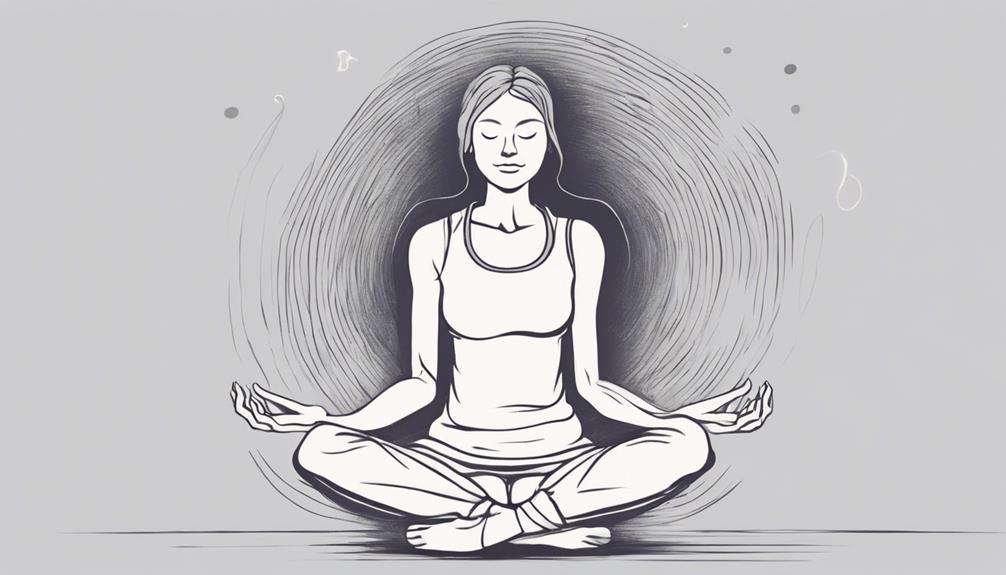If you're seeking effective pain relief methods, exploring the world of Yoga Nidra might just be your game-changer.
Imagine a world where your pain diminishes, where your mind and body find harmonious balance effortlessly…
Intrigued to discover how this practice could transform your pain management journey?
Key Takeaways
- Yoga Nidra enhances self-awareness for coping with pain.
- Deep relaxation reduces stress, improving pain management.
- Visualization practices and breath awareness techniques aid in pain relief.
- Access deep brainwave states for natural pain relief during Yoga Nidra.
Benefits of Yoga Nidra for Pain Management
Discover how Yoga Nidra can be a powerful tool for managing pain and promoting overall well-being.
Mindfulness plays a crucial role in the benefits of Yoga Nidra for pain management. By enhancing self-awareness and promoting mindfulness, this practice empowers you to better cope with pain.
Through deep relaxation, Yoga Nidra reduces stress and tension that can often exacerbate pain, offering a natural way to alleviate chronic discomfort. Additionally, regular practice can improve your sleep quality, which is essential for effective pain management.
By rewiring the brain's response to pain signals, Yoga Nidra can help mitigate chronic pain over time. Moreover, this practice triggers the release of endorphins, the body's natural painkillers, providing you with a natural and holistic approach to pain relief.
Embrace the power of mindfulness in Yoga Nidra to not only alleviate pain but also enhance your overall well-being.
Techniques for Pain Relief During Yoga Nidra
Enhance your pain management journey during Yoga Nidra by incorporating specific techniques that focus on relaxation and tension release. Here are some powerful techniques to help you find relief:
- Progressive Muscle Relaxation: Start by focusing on your index finger, tensing the muscles in that area, and then releasing the tension slowly. Move on to other muscle groups using the same technique, allowing your body to relax deeply and release any built-up tension.
- Visualization Practices: Imagine a soothing light or a healing energy surrounding your index finger, bringing warmth and comfort to the area. Redirecting your focus away from pain towards positive imagery can promote a sense of calm and help alleviate discomfort.
- Breath Awareness Techniques: Concentrate on your breath, allowing it to flow effortlessly in and out. With each inhale, imagine fresh energy entering your body, and with each exhale, visualize tension leaving through your index finger, promoting relaxation and reducing pain perception.
Incorporating Yoga Nidra for Pain Reduction

To effectively alleviate pain, consider integrating Yoga Nidra into your pain management routine. Finding a comfortable position is essential when incorporating Yoga Nidra for pain reduction. By lying down on your back with a pillow under your knees or sitting in a supportive chair, you can ensure that your body is fully relaxed and at ease during the practice. This comfortable position sets the foundation for deep relaxation, allowing you to focus on the guided meditation and body scan techniques that are key to decreasing pain perception.
Yoga Nidra works by promoting relaxation and reducing stress levels, which can help interrupt pain signals and shift your focus towards inner healing. Regular practice of Yoga Nidra can also create new neural pathways that diminish the sensation of pain. By accessing deep brainwave states through this practice, you can release tension and alleviate physical discomfort, making it a valuable tool in managing chronic pain. Remember, finding a comfortable position is the first step towards experiencing the pain-relieving benefits of Yoga Nidra.
Frequently Asked Questions
Can Yoga Nidra Help With Pain?
Yes, Yoga Nidra can help manage pain by rewiring your brain's response to discomfort, reducing pain perception, and promoting relaxation. Through mindfulness and body awareness, it offers natural relief and improved pain tolerance.
How Do I Get the Most Out of Yoga Nidra?
To get the most out of Yoga Nidra, ensure a peaceful environment, set a positive intention, and follow the guided body scan and deep breathing. Embrace the practice regularly for deep relaxation and enhanced well-being.
When Should You Not Do Yoga Nidra?
If you have specific health concerns or conditions like epilepsy, serious mental health issues, acute injuries, pregnancy in the first trimester, or a history of trauma, it's vital to acknowledge these Yoga Nidra contraindications for your well-being.
What Are the 4 Areas of Pain That Yoga Can Help Manage?
When chronic pain lingers, Yoga Nidra steps in to soothe your body and mind. It targets various areas like the lower back, neck, shoulders, and knees, offering relief through deep relaxation techniques.
Conclusion
So there you have it, folks! Just remember, when the pain is getting you down, Yoga Nidra is here to save the day.
Set those positive intentions, scan through your body like a pro, and bask in that sweet stillness. Pain relief has never been so relaxing!
Embrace the power of Yoga Nidra and say goodbye to those pesky aches and pains. Namaste and chill, my friends.






